#Sanfordiacaulis
Text
373 notes
·
View notes
Text

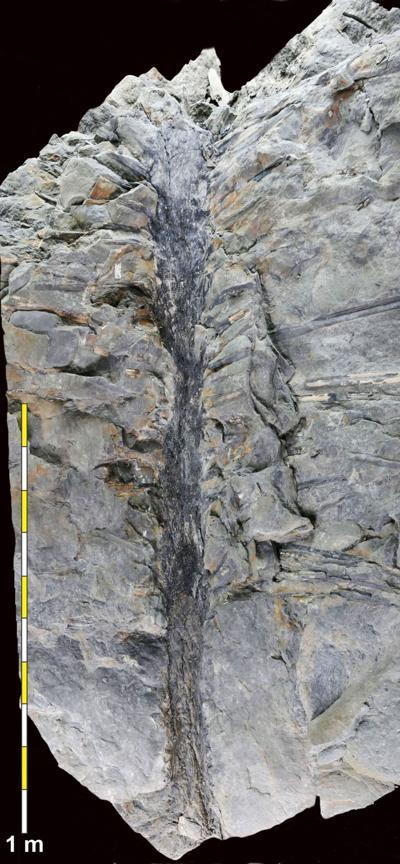
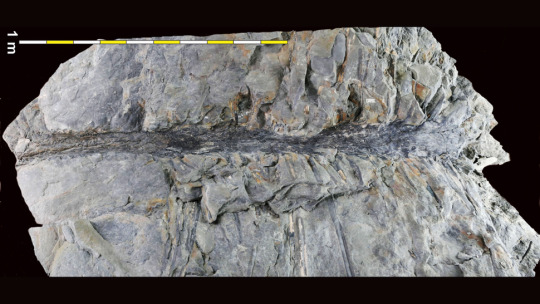
Rare 350 Million-Year-Old Tree Fossils Has Scientists ‘Gobsmacked’
Rare tree fossils preserved with their leaves have an architecture unlike any plant known today and represent the earliest evidence of smaller trees growing beneath the forest canopy.
Trees are believed to have originated hundreds of millions of years ago. Ever since, evidence of these ancient plant sentinels has been in short supply.
Now, a new discovery of uniquely 3D tree fossils has opened a window into what the world was like when the planet’s early forests were beginning to evolve, expanding our understanding of the architecture of trees throughout Earth’s history.
Five tree fossils buried alive by an earthquake 350 million years ago were found in a quarry in the Canadian province of New Brunswick, according to a study published Friday in the journal Current Biology. The authors said these new and unusual fossil trees not only bear a surprising shape reminiscent of a Dr. Seuss illustration, they reveal clues about a period of life on Earth of which we know little.
“They are time capsules,” said Robert Gastaldo, a paleontologist and sedimentologist who led the study, “literally little windows into deep-time landscapes and ecosystems.”
Coauthors Olivia King and Matthew Stimson unearthed the first of the ancient trees in 2017 while doing fieldwork in a rock quarry in New Brunswick. One of the specimens they discovered is among a handful of cases in the entire plant fossil record — spanning more than 400 million years — in which a tree’s branches and crown leaves are still attached to its trunk.
Few tree fossils that date back to Earth’s earliest forests have ever been found, according to Gastaldo. Their discovery helps fill in some missing pieces of an incomplete fossil record.
“There are only five or six trees that we can document, at least in the Paleozoic, that were preserved with its crown intact,” said Gastaldo, a professor of geology at Colby College in Waterville, Maine.
Most ancient tree specimens are relatively small, he noted, and often discovered in the form of a fossilized trunk with a stump or root system attached. For his colleagues to find a preserved tree that could have been 15 feet tall in its maturity with an 18-foot diameter crown left the paleontologist “gobsmacked.”
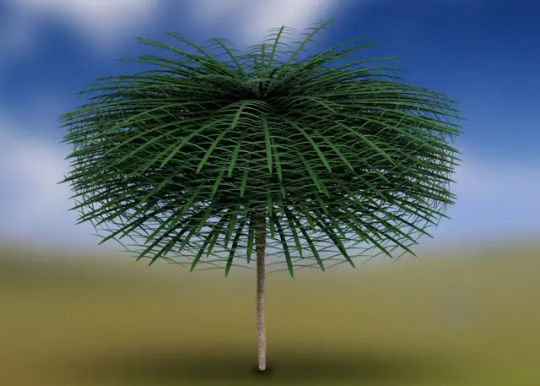

Ancient earthquake burial
The researchers excavated the first fossil tree about seven years ago, but it took another few years before four more specimens of the same plant were found in close proximity to one another. Dubbed “Sanfordiacaulis,” the newly identified species was named in honor of Laurie Sanford, the owner of the quarry where the trees were unearthed.
The forms taken by these previously unknown 350 million-year-old plants look somewhat like a modern-day fern or palm, per the study, despite the fact that those tree species didn’t appear until 300 million years later. But while the tops of ferns or palms as we know them boast few leaves, the most complete specimen of the newly discovered fossils has more than 250 leaves preserved around its trunk, with each partially preserved leaf extending around 5.7 feet (1.7 meters).
That fossil is encased in a sandstone boulder and roughly the size of a small car, according to Stimson, an assistant curator of geology and paleontology at the New Brunswick Museum.
The unique fossilization of the cluster of trees is likely due to a “catastrophic” earthquake-induced landslide that took place in an ancient rift lake, he said.
“These trees were alive when the earthquake happened. They were buried very quickly, very rapidly after that, at the bottom of the lake, and then the lake (went) back to normal,” Stimson said.
Finding complete fossil trees is rare and much less common than finding a complete dinosaur, according to Peter Wilf, a professor of geosciences and paleobotanist at Pennsylvania State University who was not involved with the study. Wilf noted via email that the “unusual” new fossil tree was a relic of a time period from which there are almost no tree fossils.
“The new fossils are a milestone in our understanding of how early forest structure evolved, eventually leading to the complex rainforest architectures that support most of Earth’s living biodiversity,” Wilf added.

‘Very Dr. Seuss’
To King, a research associate at the New Brunswick Museum who found the group of fossils, the Sanfordiacaulis would have looked like something plucked straight out of Dr. Seuss’ most popular works.
“You know in ‘The Lorax,’ the trees have these big pom-poms at the top and narrow trunks? These probably have a similar structure. You have this massive crown at the top, and then it does narrow and paper into this very small trunk,” King said. “It’s a very Dr. Seuss-looking tree. It’s a weird and wonderful idea of what this thing could look like.”
But the reign of the Sanfordiacaulis was short-lived, the researchers said. “We do not see this architecture of plant again,” Stimson said. He noted that it grew in the early Carboniferous, a time period at the end of the Paleozoic Era when plants and animals were diversifying as they started to make their way from water to land.
Much of evolution is experimental, with success often measured by a species’ versatility, or ability to adapt to many different places and conditions. The peculiar set of tree fossils presents proof of a “failed experiment of science and evolution,” Stimson added. “We’re really starting to paint that picture as to what life was like 350 million years ago.”
Looking forward
Fossils such as the Sanfordiacaulis are not just useful in helping humans understand how life changed in the past, they can help scientists figure out where life on our planet might be headed next.
The existence of this particular species suggests that trees of the period were starting to occupy different ecological niches beyond what was previously understood, according to the researchers behind its discovery.
Gastaldo sees this as an indication that plants — much like early invertebrates — were experimenting with how they adapted to the environment. The earthquake that likely led to the trees’ fossilization also offers new geological evidence of what may have been occurring in Earth’s systems at the same moment in time.
“This is really the first evidence we have of (a tree) that would be between what grows on the ground and what would tower way above the ground,” Gastaldo said. “What else was there?”
By Ayurella Horn-Muller.

#Rare 350 Million-Year-Old Tree Fossils Has Scientists ‘Gobsmacked’#New Brunswick#Fossils#Tree Fossils#paleontologist#sedimentologist#geology#Sanfordiacaulis#archeology#archeolgst#history#history news#ancient history#long post#long reads
25 notes
·
View notes
Text

A 352-million-year-old fossilized tree, Sanfordiacaulis densifolia, was found in present day New Brunswick, Canada.
Credit…Matthew Stimson
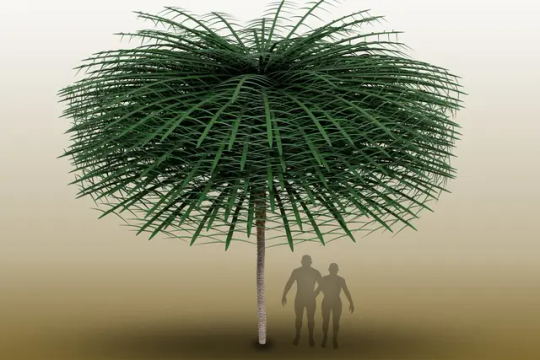
A reconstruction of Sanfordiacaulis with a simplified branching structure.
Credit…Tim Stonesifer
109 notes
·
View notes
Link
In the fossil record, trees typically are preserved with only their trunks. They don't usually include any leaves to show what their canopies and overall forms may have looked like. But now, researchers reporting in the journal Current Biology describe fossilized trees from New Brunswick, Canada with a surprising and unique three-dimensional crown shape.
8 notes
·
View notes
Text
“There are only five or six trees that we can document, at least in the Paleozoic, that were preserved with its crown intact,” said Gastaldo, a professor of geology at Colby College in Waterville, Maine.
Most ancient tree specimens are relatively small, he noted, and often discovered in the form of a fossilized trunk with a stump or root system attached. For his colleagues to find a preserved tree that could have been 15 feet tall in its maturity with an 18-foot diameter crown left the paleontologist “gobsmacked.”
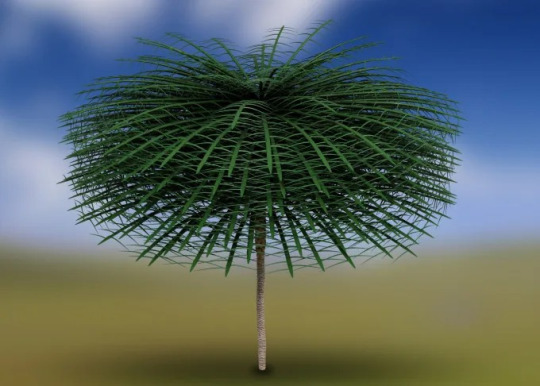
This model rendering of the newly discovered Sanfordiacaulis tree includes simplified branching structure for easier visualization. Courtesy Tim Stonesifer
5 notes
·
View notes
Text
0 notes
Text
Kanadasta on löydetty 350 miljoonaa vuotta vanhoja puufossiileja - MTVuutiset.fi
0 notes
Text
Rari fossili in 3D mostrano che alcuni alberi primitivi avevano forme diverse da quelle viste finora
Modello di Sanfordiacaulis con struttura di ramificazione semplificata per una più facile visualizzazione. Si noti che gli esseri umani sono forniti in scala, ma non esistevano contemporaneamente all’albero.
Nella documentazione fossile, gli alberi sono tipicamente conservati solo con i loro tronchi. Di solito non includono alcuna foglia per mostrare come potevano essere le chiome e le forme…

View On WordPress
0 notes
Text
Des fossiles d'arbres à l’apparence étrange découverts au Canada
See on Scoop.it - Les Colocs du jardin
Une équipe de recherche a découvert une espèce d'arbre fossilisée vieille de 350 millions d'années. Les fossiles, qui comptent parmi les plus anciens arbres connus, ont été découverts dans ce qui était autrefois un ancien lac dans le nord-est du Canada.
Guru Med | 5 Fév 2024
"L’espèce s’appelle Sanfordiacaulis densifolia et aurait élu domicile sous les plus grands membres de la canopée forestière. Les plus anciens arbres fossiles remontent à la fin du Dévonien, et ceux-ci, qui datent du début du Carbonifère, sont plus jeunes de quelques millions d’années seulement. On ne sait pas exactement quels sont les plus proches parents du Sanfordiacaulis sur l’arbre de la vie (sans jeu de mots), ce qui signifie qu’il s’agit d’un taxon incertae sedis, un taxon énigmatique."
(...)
Image d’entête : illustration du spécimen (avec des feuilles simplifiées), silhouettes humaines pour l’échelle. (Tim Stonesifer/ Cell Press)
0 notes
Text
Forests of giant, scaly-stemmed club mosses rose from ancient swamps in Atlantic Canada 350 million years ago. But below the canopy sprouted even stranger trees, whose fossils were recently discovered in a quarry in Norton, N.B.
Like the truffula, the new fossil species, Sanfordiacaulis densifolia, was a little taller than a human but not extremely tall (about three meters) and had a spindly stem poking into a dense mop of long leaves. That mop was more extreme than the truffula's in size--over five meters, or about the diameter of an above-ground pool.
Sanfordiacaulis lived at a time called the Mississippian, an early part of the Carboniferous period. It was before dinosaurs or even reptiles had evolved, and insects and salamander-like amphibians were just starting to colonize the land. At the time, New Brunswick had a subtropical to tropical climate, and its lakes were surrounded by swampy forests.
King and Stimson are both graduate students at St. Mary's University in Halifax who also work for the New Brunswick Museum. They were searching for the tracks of those early animals, often in quarries that allowed them to, because those are places where fresh rock is constantly being exposed by digging. At Sandford quarry, the sandstone comes from the bottom of a very long, ancient lake that's so deep that near its bottom, there was no oxygen to promote decay. It preserved not just fish, but sections of the surrounding forest plunged into its depths by earthquake-triggered landslides.
While searching there in 2017, King and Stimson spotted a tree trunk embedded in a boulder. As they dug it out to expose more, they realized that the trunk was attached to branches and leaves that didn't belong to anything they recognized.
They began sending photos to experts in fossil plants to help them identify it. They also contacted the quarry owner, Laurie Sanford, who offered his staff and machinery to dig the boulder out and transport it to the New Brunswick Museum. The fossil is named after him for his contributions.
Robert Gastaldo, an emeritus professor at Colby College in Waterville, Maine, was among the paleobotanists called in to help identify and study the unusual plant. He recalls walking into the room where the huge block was stored, with the tree embedded in it. "And [I] went, 'Oh wow.'" Not only was it large, but it's very unusual to find the crown of a tree preserved with a trunk, he said. It's also unusual for them to be preserved in three dimensions, instead of flattened during the fossilization process.
Study co-author Adrian Park, a geologist with the New Brunswick Department of Natural Resources and Energy Development, found evidence of earthquake-triggered landslides at the fossil site. The researchers believe the sediment that encased the tree during an ancient landslide protected it from getting crushed by additional sediment piling overtop in the hundreds of millions of years that followed.
Gastaldo said very tall club moss trees and low undergrowth plants had previously been found in forests from the Mississippian, but researchers had not yet found evidence of a middle layer of intermediate-sized trees, like those in the "subcanopy" of modern tropical forests — until this one. Its huge mop of dense foliage likely aimed to capture as much light as possible between the canopy and the undergrowth.
Gastaldo said the existence of such a strange tree suggests this was a time when plants, which had only recently colonized the land, were experimenting with many different forms and strategies. King noted that in the case of the form taken by Sanfordiacaulis, "we don't see it before this time and we don't see it after. So it's a bit of a failed experiment."
That said, Sandfordiacaulis did have fleeting success — more digging led the researchers to find another four specimens, and it turned out that many of its leaves and branches had previously been collected, though not identified, suggesting it was quite a common plant in its forest. The most similar modern plants, tree ferns and palms have far fewer leaves and didn't evolve until later.
Plant fossil researchers who weren't involved in the study were excited by the implications for what forests were like 350 million years ago. Cindy Looy is a professor at the University of California, Berkeley, who teaches a course in paleobotany and who studies how ancient plants responded to major environmental changes, such as mass extinctions and deglaciations. She said she was struck by the image of what the tree would have looked like.
Will Matthaeus is a postdoctoral researcher at Trinity College Dublin who measures and incorporates fossil plants into simulations of ancient ecosystems. He said that while plants this ancient are generally strange-looking, "this is the top of the heap in terms of an unfamiliar-looking tree."
Both Looy and Matthaeus said finding an entire tree with a trunk, branches, and leaves was very rare. But they were most excited that this tree provided the first evidence that forests were complex enough to have a middle layer of plants, even 350 million years ago, between the canopy and the undergrowth.
The new study was supported by science and research funding from the Canadian, U.S., and U.K. governments and the New Brunswick Department of Natural Resources and Energy Development.
0 notes
Text
Los primeros árboles del planeta quizá tuvieron formas muy exóticas
La mayoría de fósiles de árboles solo conservan el tronco, no las copas de hojas. Pero unos investigadores han encontrado árboles fosilizados de la especie Sanfordiacaulis en New Brunswick, Canadá, a los que sí les ha quedado la copa, y esta resulta ser sorprendente. Las hojas son numerosas y enormemente largas alrededor de un tronco muy delgado.
Las formas que adoptan estos árboles de 350…

View On WordPress
0 notes